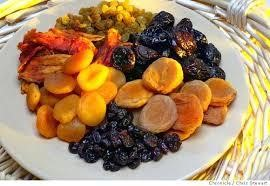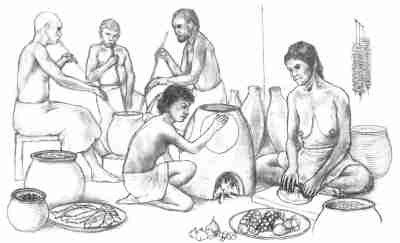"FOOD HABITS OF TAMILS" PART:10 "பண்டைய சுமேரியரின் உணவு பழக்கங்கள்" / "Food
Habits Of Ancient Sumer" [தமிழிலும் ஆங்கிலத்திலும் / In English and
Tamil]
"தமிழரின் தோற்றுவாய்? [எங்கிருந்து தமிழர்?] என்ற இதற்கு முந்திய 82 பாகங்கள் கொண்ட, தீபத்திலும் [Theebam.com] எனது வலைத்தளத்திலும் ["A DROP IN THE OCEAN / கடலில் ஒரு துளி" By Kandiah Thillaivinayagalingam] வெளியிடப்பட்ட தொடரில், நாம் ஆழமாக விவாதித்து சுட்டிக் காட்டியவாறு, பண்டைய சுமேரியர்களே அல்லது சுமேரிய தமிழர்களே வேட்டையாடுவதையும் உணவு சேகரிப்பதையும் விட்டு, விவசாயம் செய்ய முற்பட்ட முதல் நாகரிகம் ஆகும். மற்ற பல கண்டுபிடிப்புகளை உலகிற்கு முதல் முதல் கொடுத்தவாறு, விவசாயத்திலும் உணவிலும் கூட இவர்கள் தமது பங்களிப்பை உலகிற்கு முதல் முதல் வழங்கினார்கள்.
பண்டைய சுமேரியர்களின் உணவு அதிகமாக பார்லியை முதன்மையாக கொண்டதுடன், மற்றும் கோதுமை, தினை போன்றவையும் ஆகும். அங்கு விவசாயம் அவர்களுக்கு, காய்கறியும் பழங்களும் வழங்கின. அத்துடன் பட்டாணிக் கடலை [கொண்டைக் கடலை], வெங்காயம், கீரை, லீக்ஸ், பீன்ஸ் [பயிற்றினம்], உள்ளி, கடுகு, வெள்ளரிக்காய், பருப்பு போன்ற சிறு பயிர்களும் அந்நிலத்தில் காணப்பட்டன. இவைகள் எல்லாம் பண்டைய சுமேரியர்களின் உணவாக அன்று இருந்தன. இவர்களே நாடோடி வாழ்க்கையை விட்டு முதல் முதல் ஓர் இடத்தில் குடியேறிய நாகரிக மக்களும் ஆகும். அப்படி ஓரிடத்தில் குடியேறியதுடன், வீட்டு பாவனைக்கு விலங்குகளையும் பழக்கினார்கள். அவை உணவுக்கும் வேலைக்கும் அவர்களால் பாவிக்கப்பட்டன. வெள்ளாடு பாலும் இறைச்சியும் கொடுத்தன. அத்துடன் மாமிசத்தில் - மாட்டுக்கறி, வெள்ளாடு, செம்மறியாட்டுக்கறி, பன்றிக்கறி, மான்கறி மற்றும் புறா, காட்டுக் கோழி போன்றவையும், மேலும் கோழி முட்டையும் அவர்களின் முக்கிய உணவாக இருந்தன. பாபிலோனியர்களால் சுமேரியர் தோற்கடிக்கப்பட்ட தருவாயில், சிறந்த சுவையான உணவு ஒன்று அங்கு கண்டுபிடிக்கப்பட்டு, அது அரண்மனைக்கு கூடை நிரம்ப அனுப்பப்பட்டுள்ளன என்றும் அது அதிகமாக உணவுப் பண்டங்களுக்கு மணமூட்டும் ஒரு வகை பாலைவனத்து காளான் [truffles] என்றும் அறிய வருகிறது.
அவர்களின் நாளாந்த உணவு அதிகமாக பார்லி "கேக்கை"யும் பார்லி "களி"யையும் கொண்டிருந்ததுடன் இவை அதிகமாக வெங்காயம் அல்லது கொஞ்சம் அவரை சேர்த்து உட்கொள்ளப் பட்டதுடன், வாற்கோதுமை மா ஊறலிலிருந்து வடித் தெடுக்கப்படும் மதுவுடன் [பியர் / barley ale] உணவைப் பூர்த்தி செய்தார்கள். மெசொப்பொத்தேமியா ஆற்றில் கும்பலாக நீந்தும் மீனும் அவர்களின் முதன்மை உணவாக இருந்தது. அத்துடன் கடல் ஆமை, சிப்பிகள் போன்றவையும் மீனுடன் சேர்த்து சமைத்து உண்ணப் பட்டது. கி மு 2300 முற்பட்ட சுமேரிய நூல் ஒன்று, ஐம்பதுக்கு மேற்பட்ட மீன் வகைகளை குறிப்பிட்டுள்ளது. பாபிலோனியர் காலத்தில் மீன் வகைகளின் எண்ணிக்கை குறைந்து இருந்த பொழுதிலும், ஊரின் [Ur] குறுகிய, சுற்று தெருக்களில், பொரித்த மீன் விற்கும் வணிகர்கள் அங்கு வளமான வர்த்தகம் செய்தார்கள் என அறியமுடிகிறது. அது மட்டும் அல்ல, அங்கு உணவு கூடங்களில் வெங்காயம், வெள்ளரிக்காய், சுடச் சுட வாட்டிய ஆட்டிறைச்சி, பன்றி இறைச்சி போன்றவை வாங்கக் கூடியதாகவும் இருந்தன. இந்த பண்டைய சுமேரியர் காலத்தில், இன்று காணப்படுவது போல,அண்மை கிழக்கு நாடுகளில் [Near East Countries] பன்றி இறைச்சி விலக்கப்பட்ட ஒன்று அல்ல என்பது குறிப்பிடத்தக்கது! என்றாலும், கி மு 1000 ஆண்டு அளவில் இருந்து பன்றி இறைச்சியின் நிலை மாறத் தொடங்கியது. பண்டைய எகிப்தில் பன்றி ஒரு "அசுத்த பிராணி" என பொதுமதிப்பு பெற்றது. அத்தருவாயில், எகிப்திய கீழ் சமுதாய வகுப்பினர் பன்றியை சாப்பிட தடை செய்யப்படாவிட்டாலும், மேல் வகுப்பினருக்கு, குறிப்பாக மதகுருமாருக்கு இது முற்றாகத் தடை செய்யப் பட்டது. இந்த நிலை இன்னும் ஒரு சில சமய குழுக்களிடம் இன்றும் தொடர்கிறது. அதன் பிறகு, ஏறக்குறைய கிமு 500 முதல் இஸ்லாம் நிறுவப்பட்ட காலம் வரை, மத்திய கிழக்கில் பன்றி இறைச்சி ஒரு அசாதாரண இறைச்சியாக இருந்தது. அதே போல சில யூத தரப்பும் சில கிரிஸ்துவ தரப்பும் பன்றி இறைச்சியைத் தவிர்த்தன. சுமேரியாவில் நிலவிய வெக்கையில் இறைச்சி விரைவாக கெட்டுப் போவதால், அதிக மக்கட் தொகை இல்லாத கிராமப் புறங்களை விட, சுமேரிய நகரங்களில் இறைச்சி பொது உணவாக அங்கு வாழும் மக்களிடம் இருந்தன. மேலும், கால்நடைகள் அவற்றின் இறுதி கால வாழ்க்கையின் முடிவில் இருக்கும் போது மட்டுமே நுகர்வுக்காக படுகொலை செய்யப்பட்டன என்பதும் குறிப்பிடப்பட்டது. அதுமட்டும் அல்ல, நிச்சயமாக ஆட்டிறைச்சியே மிகவும் பொதுவானதாக காணப்பட்டது.
தொல்பொருள் ஆராய்ச்சி, ஆப்பெழுத்து / கியூனிபார்மில் எழுதப்பட்ட பதிவுகள், மற்றும் சுமேரிய - அக்காத் இருமொழி ஆவணங்கள் மூலம் நாம் பண்டைய சுமேரியர்களின் உணவு பற்றி விரிவாக இன்று அறிய முடிகிறது. பார்லி ரொட்டியின் [barley bread] முக்கியத்தையும் பலவித பார்லி ரொட்டிகளையும் இந்த ஆவணங்கள் சுட்டிக் காட்டுகின்றன. இவற்றுடன் பார்லி, கோதுமை கேக்கும் [barley and wheat cakes] சுமேரியர்களின் பிரதான உணவாக இருந்ததுடன், அவையுடன் தானியம், பயறு [பருப்பு] சேர்ந்த வடிசாறுடன் [சூப்பு / கஞ்சி] [grain and legume soups], வெங்காயம், லீக்ஸ், உள்ளி, டர்னிப் [turnip] போன்றவை உண்ணப்பட்டன. மேலும் காய்கறிகளைத் தவிர, சுமேரியர்களின் உணவில் பழங்களும் இருந்தன. அவை ஆப்பிள், வெள்ளரிப்பழம், திராட்சை, அத்திப்பழம், பேரீச்சை, மாதுளை போன்றவையாகும். பிந்திய சுமேரியன் பதிவுகளில் பல சமையல் மூலிகைகள், தேன், சீஸ் [பாலாடைக்கட்டி / cheese], வெண்ணெய் [butter], தாவர எண்ணெய் போன்றவையும் குறிப்பிடப் பட்டுள்ளன. தேன், பேரிச்சை, திராட்சை சாறு போன்றவை இனிப்பு பொருள்களாகவும் பயன்பட்டன. அத்துடன் சுமேரியர்கள் அடிக்கடி பியர் [beer] குடித்தார்கள். ஆனால் சிலவேளை கொடி முந்திரிப் பழச்சாறும் [wine] குடித்தார்கள். பல வித பதப்படுத்தப் பட்ட உணவுகளும் அங்கு காணப்பட்டன. உதாரணமாக காய்ந்த ஆப்பிளும் அத்தியும் சரமாக கோர்த்து சுவரில் தொங்க விடப் பட்டிருந்தன. அத்துடன் தேனில் பழங்கள் பாதுகாக்கப் பட்டன. அதே போல பருப்பு வகைகளான பீன்ஸ், பட்டாணி, பயறு போன்றவையும் அத்துடன் திராட்சையும் உலர வைக்கப்பட்டன. மேலும் பாதம் கொட்டை [almonds], பசுங்கொட்டை [pistachio], உள்ளி போன்றவை நெடுங்காலம் காய்ந்த நிலையில் அங்கு வைக்கப்பட்டன. அங்கு நிலவிய சூடான காலநிலையில் பால் விரைவில் கெட்டு விடும். ஆகவே சுமேரியர்கள் பாலை நெய், சீஸ் ஆக மாற்றினர். மீனை உப்பு போட்டு அல்லது புகை பிடித்து வெயிலில் உலர்த்தினர் [கருவாடு]. இறைச்சியை ஊறுகாயாக மாற்றினர். சுமேரியர்கள் பொது பானையில் இருந்து பியரை, நாணல் குழாய் ஊடாக, அதை சுற்றி ஒன்றாக கூடியிருந்து,உறுஞ்சி குடித்தார்கள். என்றாலும் செல்வந்தர்கள் வெள்ளியால் செய்யப்பட்ட உறிஞ்சு குழாய் [straw] பாவித்தார்கள். மேலும் மதுபானங்களை அத்தியில் இருந்தும் பேரீச்சம்பழத்தில் இருந்தும் தயாரித்தார்கள். அத்துடன் திராட்சை பழத்தில் இருந்து வைனும் [Wine] உற்பத்தி செய்தார்கள். வெங்காயம், லீக்ஸ், உள்ளி போன்றவையே அங்கு பிரபல்யமானவை. இவை பாபிலோன் மன்னர் மேரோடச் பாலடன் II [Merodach Baladan II ] தோட்டத்திலும் கி மு 2100 ஆண்டு ஊர் நகர மன்னன் ஊர்-நம்மு [Ur-Nammu] தோட்டத்திலும் வளர்ந்தன என்பதற்கு ஆதாரங்கள் உண்டு.
நன்றி
[கந்தையா தில்லைவிநாயகலிங்கம்,
அத்தியடி, யாழ்ப்பாணம்]
பகுதி : 11 தொடரும்
Theebam.com: "தமிழரின் உணவு பழக்கங்கள்" பகுதி: 11:
"FOOD HABITS OF
TAMILS" PART: 10 "Food Habits Of Ancient Sumer"
As we have pointed
out & discussed deeply in our previous
Article Series titled "தமிழரின் தோற்றுவாய்? [எங்கிருந்து தமிழர்?] / Origins of Tamils? [Where are Tamil people from?]" published
in Theebam.com and my personal blog "A DROP IN THE OCEAN/கடலில் ஒரு துளி" By Kandiah
Thillaivinayagalingam, Sumerians were the first culture to quit hunting and
gathering food and begin cultivation. Like many other inventions that Sumerian
culture gave to the world, they also contributed in farming and food. Sumerian
diet mainly consisted of barley.
The raw materials of
the Sumerian diet were barley, wheat and millet. Farming yielded vegetables and
fruits, chickpeas, lentils, beans, onion, garlic, leeks, cucumbers, cress,
mustard and fresh green lettuce was all part of the early Sumerian food.
Sumerians were the first culture to settle down and leave the earlier nomad
lifestyle. With settlement they began domesticating animals for food and
labour. Goat's milk and meat, eggs, pig; wild fowl, deer and venison were an
integral part of the Sumerian's food as well. By the time Sumer was succeeded
by Babylon a special delicacy had been discovered that was dispatched to the
royal palace by the basketful, Truffles, may be desert truffles.
Everyday meals
probably consisted of barley paste or barley cake, accompanied by onions or a
handful of beans and washed down with barley ale. Fish that swarmed in the
rivers of Mesopotamia were a major food source too. Over fifty different types
of fish are mentioned in texts dating before 2300 BC, and although the number
of types had diminished in Babylonian times, the fried-fish vendors still did a
thriving trade in the narrow, winding streets of Ur. Onions, cucumbers, freshly
grilled goat, mutton and pork were available from food stalls. Pork not yet
taboo in the Near East!, However, all of this began to change very rapidly in a
variety of communities around the region starting roughly 1000 BC. Around this
time, in ancient Egypt, pigs acquired a reputation for being unclean, a view
that seems to have stuck through modern day. While lower castes of Egyptian
society were not prohibited from eating pork, it was discouraged, and the
priestly caste was forbidden from it entirely. Slightly later, from roughly 500
BC to the time of the founding of Islam, pork was an uncommon meat in the
Middle East. Also Various Jewish and Christian sects too still adhere to this
rule. Meat was commoner in the cities than in the more thinly populated
countryside, since it spoiled so quickly in the heat. Further, Cattle were only
slaughtered for consumption when they were nearly at the end of their working
lives-certainly more common was mutton.
Information about
Sumerian food can be gathered from archaeology and written records on cuneiform
tablets including bilingual Sumerian-Akkadian word lists. These sources also
indicated the importance of barley bread, of which many kinds are named, and
barley and wheat cakes, as the staple diet together with grain and legume
soups, onion, leeks, garlic and melon. Besides farmed vegetables, Sumerian food
also included fruits. These were apples, fig and grapes. Several culinary herbs
and honey and cheese, butter and vegetable oil have also been mentioned in
later Sumerian food records. Sumerians drank beer often and sometimes wine too.
Many types of preserved food were produced in ancient Sumer. These included
dried figs and apples, which were thread on string, hanging on the wall and
also fruits conserved in honey. Pulses such as beans, peas,and lentils were
also dried, as were grapes to produce raisins. Nuts too, such as almonds and
pistachio that were eaten in Sumer can be kept a long time in dry conditions as
can garlic. Milk, because it did not keep well in the hot climate, was mainly
used to make yogurt, or a form of butter known as ghee and cheese. Fish were
often dried, salted, or smoked and meat was pickled. Beer was often drunk
through a reed from a communal pot, or using a silver straw if you were
wealthy. Wine was also produced from grapes, in addition to the alcoholic
beverages produced from figs and dates. Onions and leeks and garlic were
amongst the most frequently cultivated plants. They were grown in the gardens
of King Merodach Baladan II of Babylon, and Ur-Nammu of Ur (2100 BC).
Thanks
[Kandiah
Thillaivinayagalingam,Athiady, Jaffna]
PART : 11 WILL
FOLLOW
















0 comments:
Post a Comment